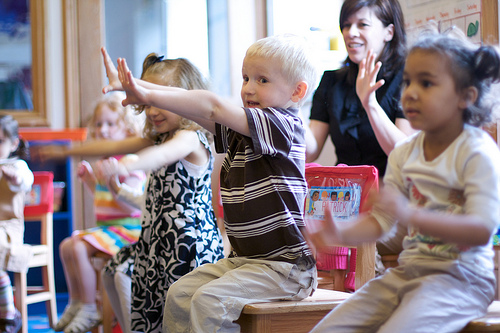 Songs are a great way for children to learn English. In this post, Devon Thagard, co-owner of Super Simple Learning and songwriter for the new Primary level course, Everybody Up, explores the benefits of using songs in class.
Songs are a great way for children to learn English. In this post, Devon Thagard, co-owner of Super Simple Learning and songwriter for the new Primary level course, Everybody Up, explores the benefits of using songs in class.
This past year, I had the great pleasure to be involved in the Everybody Up Global Sing-along as one of the songwriters, a contest judge, and a workshop leader. The entire experience reinforced and reminded me of the strong feelings I have about 1) the power of songs in the classroom, and 2) the importance of learning from other teachers.
The Global Sing-along received over 70 entries from countries all over the world. When you see classrooms around the world all enjoying singing the same songs, it really brings home the universal benefits of songs as teaching tools. Songs allow all ages to participate and learn at their levels. In the Global Sing-along videos, we see pre-schoolers and kindergartners (like these great students from Ukraine) doing some very simple dancing, picking up a few words, and getting a feel for the rhythm. For very young students who are just beginning to learn English, songs provide a fun, welcoming way to get that oh-so-valuable input, and gestures and dancing help them understand and internalize the meaning.
Older and more advanced students are able go beyond the basics and to express their creativity with songs. As students move into higher grades, they may be a little more reluctant to sing and dance as they did in kindergarten, but that doesn’t mean they don’t enjoy learning with songs, and the benefits of the repeated exposure to comprehensible input continue. At all ages, students are learning vocabulary, pronunciation, intonation, the rhythm of the language, listening skills, and more. Here are some great examples from Thailand, Korea, Turkey and France.
It’s also fantastic to be able to visit our fellow teachers’ classrooms around the world through video. Just having the chance to see how the classrooms are arranged and decorated sparks a lot of great ideas, but being able to see how teachers are using dance, crafts, instruments, and drama together with songs is really inspiring. If you haven’t already, browse the playlist of Global Sing-along videos. I’m sure you’ll come away from it with several great ideas for your classroom.
How do you use songs in your classes?


Constantly. It’s awesome how students get involved during song classes.
This is to all of you who love fun music and great educational resources! You’ll love Hugo and friends, a CD for kids of all ages!
This is the very first work of the kind because it is what I like to call – a “culturally sensitive” project – he sings about about a Hippo called Hugo that goes around on a journey meeting awesome animals around the world.
My two favorites are Toco the Toucan (Brazil) and Gigi (the French poodle) It is really good stuff, check out his Kickstarter project, and pledge to get this awesome material and other unique and cool stuff!
https://www.kickstarter.com/projects/220681525/hugo-and-friends-around-the-world
I’m a Grade 1 ESL teacher. A month ago, I started using songs more often in my classroom. I prepared a playlist of various songs on a CD, and I employed it as a tool for entertainment, discipline, and learning. It is highly effective and can do wonders. My students have become more motivated, active, and effective.
The sing-along time is specified, either as a warm up or as a relief between tasks. The most beautiful thing about it all is that students acquired terms and phrases via these songs!